Home / Construction / What kind of roofing should you choose to transform a garden shed into a habitable room? (español – italiano – français)
What kind of roofing solutions to convert a garden shed or an annex into a habitable room?
Share this page
Choosing the roof covering for a shed or a habitable annex
The purpose of this article is to present an overview of roof covering solutions in the context of a construction, rehabilitation or renovation of a garden shed or an annex.
The aim is to create a habitable room and to review all main roofing solutions for any type of slope (slight, steep, flat, etc.). The roofing has a primordial role in the protection of a structure, it must comply with strict standards defined in the Building code.
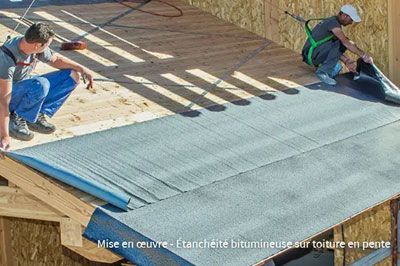
Installation of bituminous waterproofing membranes – Source SOPRAFIX SOPREMA
Factors influencing the choice of a roofing system are:
- the roof slope,
- the durability of the material over time,
- the mechanical strength and impact resistance (hail),
- the wind resistance and more generally roofing exposure (snow/wind),
- the fire resistance,
- the length of the slope,
- the simplicity of installation,
- the ecological and recyclable aspect,
- the aesthetic aspect,
- the possibility of integrating photovoltaic panels,
- the price.
Lightweight roof coverings
The lightweight covering solutions are adapted to garden shelters and sheds cabanons but also to habitable annexes.
The main solutions:
- bituminous shingles or bituminous heat activated shingles (also called bardoline@, canadian shingle or asphalt shingle),
- the rolls of bituminous felt (bitumen felts), or the bitumen waterproofing membranes for flat roofs.
- the corrugated bitumen sheets,
- the corrugated sheets of pvc, polycarbonate or polyester,
- the corrugated steel sheets (tile or slate imitation),
- the lacquered steel sheets with or without insulant (sandwich panel)
The bituminous shingles (or bardoline@):
- lightweight,
- waterproof (water, air, snow),
- aesthetic: various shapes (square, tortoiseshell, ogive) and colours,
- suitable for all slopes (including slight slopes starting from 15% or 9°),
- durable and good mechanical strength (very resistant to the impact of hail), stable to temperature variations
- wind resistant (no risk of detachment),
- fire resistant,
- simple fastening by galvanised spikes, bonding or nailing and thermo-adhesion by heating.
- for regions with average hygrometry.
- Price: £10-25/m2
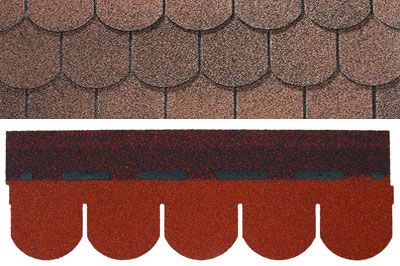
Solutions of lightweight roof covering – Soprema Beaver Tail Bituminous Shingle
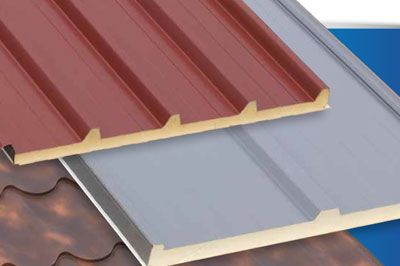
Lightweight roofing solutions – Galvanised steel sheet with BATIROC insulation
The galvanised steel sheets (roofing profile for covering):
- Lightweight, coated with a polyester lacquer and underside condensation regulator felt (absorption-evaporation).
- Coupled with a sandwich insulation or anti-condensation felt (on option).
- Waterproof (water, air, snow),
- Various colours (many RAL available). Simple shapes or tile imitations.
- Dimensions: custom length (1 to over 10 meters) x 1 meter width x low height (36 mm-45 mm).
- Suitable for all slopes (including low slopes from 7% or 4°),
- Durable and good mechanical strength (very resistant to impact of hail), stable to temperature variations
- Wind resistant (no risk of detachment),
- Fire resistant (M1),
- Simple fixing by galvanised nails (nailing)
- For regions with low or average hygrometry.
- Price: £20-30/m2
An eco-responsible solution by nature, the wood tiles are mainly in larch (grey-silver hue), in chestnut, in oak. The wooden shingle is:
- Light (35 kg/m2),
- Durable (30 to 40 years) without maintenance of the wood,
- Great aesthetic freedom (regular, irregular, rounded installation) and guaranteed authenticity,
- For regions with low or average hygrometry,
- For slopes of minimum 30° to avoid water stagnation (the higher the slope the greater the lifetime),
- Rather long except for specific solutions (shingle embedded in grooved battens attached to rafters (@wood ambiance solution)). Fixing of the shingle by pointing.
- Advice: ensure that the shingle does not contain more than 5% of sapwood,
- Dimensions: shingle 9 to 21 cm wide, 16 mm thick, 60 to 100 cm long, exposure of 30 cm (uncovered part = third of the length of the shingle),
- Price: £35/m2 excluding installation.
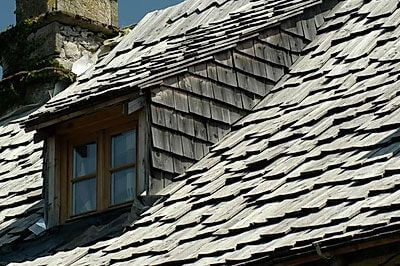
Lightweight roofing solutions – Wood shingle – Source Limousin Wood Ambiance
Traditional roof coverings
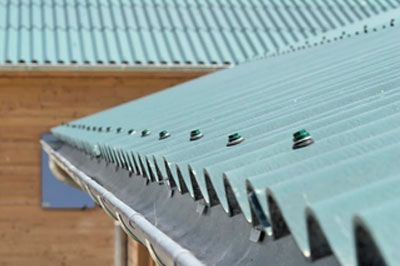
Fibre cement roofing – Coloronde Ethernit
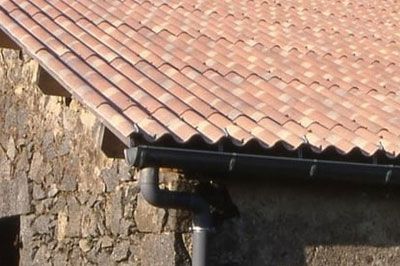
Corrugated fibre cement – Ethernit
Among the classic roofing solutions, the corrugated fibre-cement asbestos-free sheets offer aesthetic possibilities that are often overlooked, such as the roman tile type (several colours to choose from).
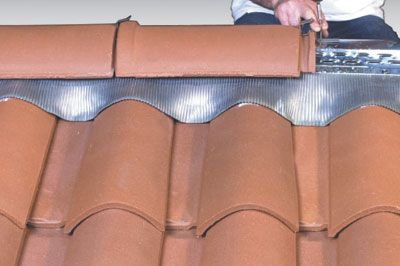
Terracotta roofing tiles – source: Edilians
The choice of the interlocking terracotta tiles depends on the architectural project and the environment in which it is integrated. The choice is large: strongly or slightly curved, plain, etc.
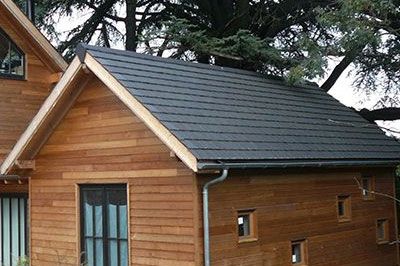
Rectangular slate roofing tiles – source: Edilians
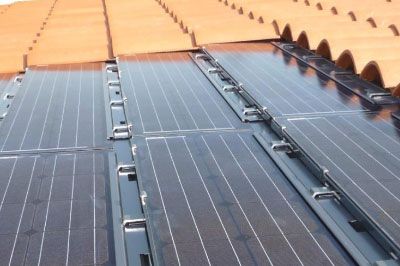
Photovoltaic roofing tiles – source: Edilians
The metal roofs of wrought zinc sheets have many advantages including the longevity (without maintenance) and timeless aesthetics. It also allows complexe convex, concave and wedge-shaped shapes. Composed of standard tray and finishing profiles, the Tasseau Plus system from Rheinzink is a complete ready-to-install roof covering system presenting the aesthetics of a traditional batten roof covering. These sheets are also available in copper or in aluminium.
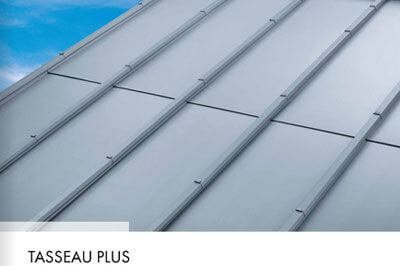
Zinc roofing – source : Rheinzink
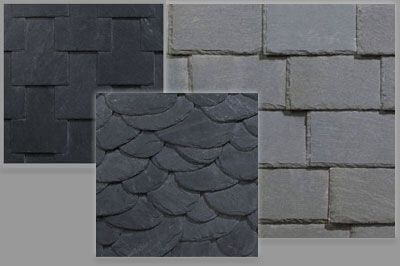
Different slate installation types – source: Rathscheck Schiefer
The natural or manufactured slates blend perfectly into regional landscape due to great diversity of:
- materials (natural, fibre cement),
- shapes (rectangle, square) and installation techniques,
- colours and finishes.
This great diversity of possibilities allows more or less refined or worked aesthetic solutions bringing charm and personality to your roofing. Slates have the distinction of being robust, light and resistant over time. Natural slates are recognised to be the most durable and aesthetic.
The thatch is a natural material made up from reed stalks (initially wheat or rye straws). It has an excellent durability (30 to 40 years expected) while ensuring both waterproofing and sound (hail, heavy rain, …) and thermal insulation (summer as winter). Modern techniques eliminate the initial risk of fire. The roof pitch must be greater than 35° in order to avoid water stagnation and rotting of the material. No more fire risks than any other roofing materials (thanks to the strong compression of the material).
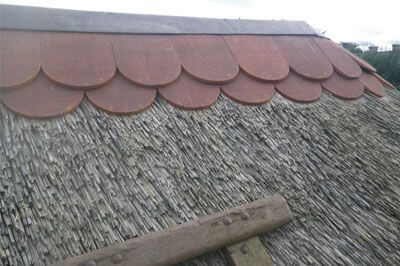
Thatch roofing – source: Chaumier Ile de france
Maintenance of a thatched roof:
- by an anti-foam preventive and curative spraying,
- by brushing of the areas requiring it,
- by repairing various localised degradations and wear and tear.
Waterproofing solutions for accessible or inaccessible flat roofings (plain – slope 0 to 5%)
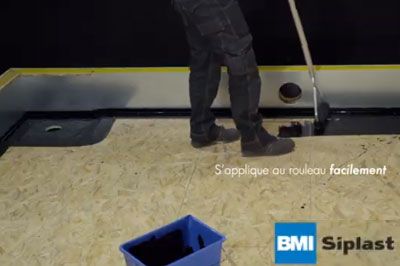
Complete waterproofing system for flat roofs with wooden support – BMI Siplast
Siplast offers an ADESTAR waterproofing system for flat roofing directly applicable on the support element (wood – including OSB panels – or masonry). The waterproofing is achieved by the combination of a primer (applicable with a roller), an adhesive monolayer elastomer membrane based on bitumen, a parathane mat reinforcement, and a supracoating. The flameless bonding (100% cold) greatly simplifies the installation.
The waterproofing system is available in various colours. It allows the use of terraces (flat roofs) for the inhabitants with an apparent self-protected waterproofing membrane. It is also possible to cover the membrane with gravel, synthetic grass, paving slabs on pads or vegetation (terrace-garden).
This innovative system also exists as direct installation on the insulation.
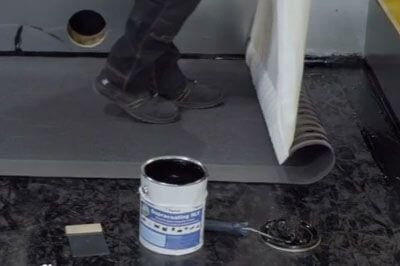
Complete waterproofing system for flat roofs with wooden support – BMI Siplast
Comparison between different roofing solutions
| Comparison of roofing solutions for light covering
|
Advantages | Disadvantages |
|---|---|---|
| Asphalt shingles
|
Waterproof (rain, air, powdery snow), light, aesthetic (various shapes / colours), all slopes +20%, durable, good mechanical resistance (hail in particular), great wind resistance, little sensitive to temperature variations (frost resistant), fire resistant, easy to install (nailed or glued) | Low or medium hygrometry areas. |
| Wood shingles | Light, very aesthetic (various shapes / authenticity), very durable, eco-friendly. | Low or medium hygrometry areas/ Slopes +30°. Expensive. |
| Galvanised steel sheets | Waterproof (rain, air, powdery snow), light, all slopes +7%, little sensitive to temperature variations, fire resistant, very easy installation | Low or medium hygrometry areas. The ventilation on the inside of the attic must be well distributed and sufficient to ensure the evaporation of moisture. |
| Terracotta tiles (plain, canal, curved, etc) | Durability, diversity of aesthetic choices (models, colours) | Large number of tiles per m2 / high weight with the need for a frame. Sloped roofings of 15 to 25% minimum. |
| Slates | Durability, diversity of aesthetic choices (models, type of installation, colours) | Sloped roofings of 25 to 45% minimum. |
| Waterproofing systems for flat roofs | Waterproof, aesthetic (wide diversity of covering solutions – grass, gravel, …), flat roofs (from 0 to 20% of slop), durable (high resistance to cracking, punching and ageing), good mechanical resistance, light, easy installation (cold without blowtorch) | Low or medium hygrometry areas. |
| Corrugated fibre-cement sheets | Ideal for high hygrometry areas. Naturally anti-condensation and anti-corrosion. High durability of the coverings. Noise reduction in case of rain or hail. | Weight when installing. More limited aesthetic possibilities. |
| Zinc covering system | Without maintenance, long lasting and durable. Timeless aesthetic. Possible implementation of complex shapes (convex, concave, etc.) on low slopes ≥ 5% (3°) or for steep slopes (from 173 % (60°)). | Price. |
| Thatched roofing | 3 in 1: waterproof, acoustic insulation and aesthetic (rustic charm). Renewable resource. Insensitive to snow / hail / frost. Durability. Does not require a large frame due to relatively light weight. Relatively high cost related to installation time but offset by a lighter frame, less insulation and lack of gutters). Resistant to rodents. | On slopes ≥ 35° (70%). Just few professionals for installation. Maintenance every 5 years. |
Other topics that may be of interest to you
To know more about how to calculate the parameters of a roof slope
To know more about The best insulation for building
To know more about Identifying thermal bridges and preventing mould
EN-FOX52








